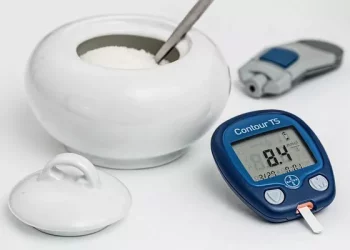Insulin resistance is a condition where the body’s cells become less responsive to insulin, a hormone produced by the pancreas that helps regulate blood sugar levels. As insulin resistance develops, the pancreas compensates by producing more insulin to manage blood glucose levels, but over time, this can lead to elevated blood sugar levels and, eventually, type 2 diabetes. Identifying the signs of insulin resistance early is essential for preventing its progression and managing associated risks. This article explores the various signs, symptoms, and risk factors that can indicate the presence of insulin resistance.
The Importance of Insulin and Its Role in the Body
How Insulin Functions in Regulating Blood Sugar
Insulin plays a vital role in helping cells absorb glucose, the body’s primary source of energy. After eating, carbohydrates are broken down into glucose, which enters the bloodstream. The pancreas responds by releasing insulin, which facilitates the entry of glucose into the body’s cells for energy production or storage.
When the body becomes resistant to insulin, glucose cannot enter cells as effectively, resulting in elevated blood glucose levels. The pancreas works harder to produce more insulin to compensate, leading to hyperinsulinemia (high insulin levels in the blood). Over time, this compensatory mechanism fails, and blood sugar levels rise, increasing the risk of developing type 2 diabetes and other metabolic complications.
Key Signs of Insulin Resistance
Recognizing the signs of insulin resistance is crucial for early diagnosis and intervention. While insulin resistance may develop silently over time, there are several noticeable signs and symptoms that may indicate its presence. Below are some of the most common indicators.
1. Elevated Blood Sugar Levels
One of the most obvious signs of insulin resistance is elevated blood sugar levels, which can be detected through routine blood tests. While high blood sugar is a hallmark of diabetes, it can also indicate prediabetes—a condition in which blood glucose levels are higher than normal but not yet high enough to be classified as type 2 diabetes.
Individuals with insulin resistance may experience fasting blood glucose levels between 100 and 125 mg/dL, which is considered prediabetic. This condition signals that the body is struggling to regulate glucose effectively, and without intervention, it can progress to full-blown diabetes.
2. Acanthosis Nigricans
Acanthosis nigricans is a skin condition often associated with insulin resistance. It presents as dark, thick, and velvety patches of skin, typically in areas where the skin folds, such as the neck, armpits, groin, and knuckles. The condition occurs due to high levels of insulin circulating in the bloodstream, which stimulates skin cells to multiply and produce excess pigment.
Acanthosis nigricans is more common in individuals who are overweight or obese, but it can also appear in people with a genetic predisposition to insulin resistance. The appearance of this skin condition is a visible and early warning sign that insulin resistance may be present.
3. Weight Gain, Particularly Around the Abdomen
Weight gain, especially in the abdominal area, is a major risk factor and sign of insulin resistance. Central obesity, or the accumulation of visceral fat around the organs, is closely linked to metabolic dysfunction, including insulin resistance. This type of fat is particularly harmful because it produces inflammatory molecules and hormones that interfere with insulin’s ability to function properly.
Individuals with insulin resistance often struggle with weight management and may find it difficult to lose weight despite efforts to exercise and eat a balanced diet. A waist circumference of more than 35 inches for women and 40 inches for men is considered a sign of increased risk for insulin resistance and metabolic syndrome.
4. Fatigue and Low Energy Levels
Fatigue is a common symptom of insulin resistance and can occur even when a person is getting enough sleep. This is because insulin resistance interferes with the body’s ability to efficiently use glucose for energy. As a result, cells do not get the energy they need, leading to feelings of constant tiredness and sluggishness.
Individuals with insulin resistance may experience a lack of motivation, difficulty concentrating, and an overall sense of low energy. These symptoms are often mistaken for general fatigue or stress but may actually be linked to underlying metabolic dysfunction.
5. High Blood Pressure
Hypertension, or high blood pressure, is another sign that insulin resistance may be present. Insulin resistance can lead to increased sodium retention by the kidneys, which raises blood pressure. Additionally, the excess insulin in the bloodstream may contribute to the stiffening of blood vessels, further increasing blood pressure.
Studies have shown a strong link between insulin resistance and hypertension, as both conditions are part of a cluster of risk factors known as metabolic syndrome. Managing blood pressure is essential for individuals with insulin resistance, as uncontrolled hypertension increases the risk of cardiovascular disease.
6. High Levels of Triglycerides and Low HDL Cholesterol
Another sign of insulin resistance is an abnormal lipid profile, known as dyslipidemia. This typically involves high levels of triglycerides (a type of fat found in the blood) and low levels of high-density lipoprotein (HDL) cholesterol, often referred to as “good” cholesterol. Insulin resistance disrupts the body’s ability to process fats properly, leading to an imbalance in these lipid levels.
Elevated triglycerides and low HDL cholesterol are significant risk factors for cardiovascular disease. A triglyceride level of 150 mg/dL or higher, along with low HDL cholesterol (below 40 mg/dL for men and 50 mg/dL for women), may indicate the presence of insulin resistance and metabolic syndrome.
7. Polycystic Ovary Syndrome (PCOS)
Polycystic ovary syndrome (PCOS) is a hormonal disorder that affects women of reproductive age and is often linked to insulin resistance. Women with PCOS may experience irregular menstrual cycles, infertility, excessive hair growth (hirsutism), acne, and weight gain. Insulin resistance is a key factor in the development of PCOS, as elevated insulin levels can lead to an overproduction of androgens (male hormones), which disrupt normal ovulation.
PCOS is one of the most common signs of insulin resistance in women and can significantly impact fertility and overall health. Managing insulin resistance through lifestyle changes and medication can help alleviate the symptoms of PCOS.
8. Increased Hunger and Sugar Cravings
Individuals with insulin resistance often experience increased hunger and cravings for sugary foods. This occurs because insulin resistance prevents glucose from entering the cells effectively, leading to elevated blood sugar levels. In response, the pancreas produces more insulin to try to lower blood sugar, but the body’s cells remain resistant to the hormone.
This cycle of high blood sugar and high insulin levels can cause blood sugar to drop rapidly after meals, leading to feelings of hunger, even after eating. This phenomenon, known as reactive hypoglycemia, can lead to overeating and weight gain, further exacerbating insulin resistance.
9. Sleep Problems and Sleep Apnea
Sleep problems, including sleep apnea, are commonly associated with insulin resistance. Sleep apnea is a condition in which breathing repeatedly stops and starts during sleep, often due to airway obstruction. This condition is more common in individuals who are overweight or obese, both of which are risk factors for insulin resistance.
Sleep disturbances can worsen insulin resistance by contributing to hormonal imbalances, inflammation, and stress on the body. Poor sleep quality, in turn, makes it more difficult to manage weight and maintain healthy blood sugar levels, creating a vicious cycle.
10. Skin Tags
Skin tags are small, soft, benign growths of skin that often appear on the neck, underarms, and other areas of the body where the skin folds. While skin tags are generally harmless, they are more common in individuals with insulin resistance and type 2 diabetes. The exact connection between insulin resistance and skin tags is not fully understood, but high levels of insulin may promote the growth of these skin lesions.
The presence of multiple skin tags, especially in areas such as the neck and underarms, may be a subtle sign of insulin resistance and should be evaluated by a healthcare provider.
Risk Factors for Insulin Resistance
Several factors increase the likelihood of developing insulin resistance. Some of these risk factors are modifiable, while others are not. Understanding these risk factors can help individuals take preventive measures and seek early intervention.
1. Obesity
Obesity, particularly abdominal obesity, is one of the strongest risk factors for insulin resistance. Excess fat, especially around the abdomen, interferes with the body’s ability to use insulin effectively. Losing weight, even a small percentage of body weight, can improve insulin sensitivity and reduce the risk of developing type 2 diabetes.
2. Sedentary Lifestyle
A lack of physical activity contributes to insulin resistance by reducing the body’s ability to use glucose for energy. Regular exercise, particularly aerobic and strength training, helps improve insulin sensitivity and lower blood sugar levels.
3. Family History of Diabetes
Individuals with a family history of type 2 diabetes are more likely to develop insulin resistance. Genetic factors play a role in how the body responds to insulin, making some people more prone to insulin resistance.
4. Age
Insulin resistance tends to increase with age. As people get older, their cells become less responsive to insulin, which can lead to higher blood sugar levels. However, lifestyle changes can still significantly reduce the risk of developing insulin resistance, even in older adults.
5. Ethnicity
Certain ethnic groups, including African Americans, Hispanic/Latino Americans, Native Americans, and Asian Americans, have a higher risk of developing insulin resistance and type 2 diabetes. The reasons for this increased risk are not fully understood but may involve genetic and environmental factors.
Managing and Preventing Insulin Resistance
Lifestyle Changes and Medical Interventions
Early detection and management of insulin resistance are essential for preventing its progression to type 2 diabetes and other metabolic disorders. The following strategies can help manage and reduce insulin resistance:
Weight Loss: Losing even 5-10% of body weight can improve insulin sensitivity and lower blood sugar levels.
Exercise: Regular physical activity, including aerobic exercise and strength training, enhances the body’s ability to use insulin and glucose.
Healthy Diet: A balanced diet rich in whole grains, fruits, vegetables, lean proteins, and healthy fats can help regulate blood sugar levels.
Medication: In some cases, medications such as metformin may be prescribed to improve insulin sensitivity and lower blood sugar levels.
See also: What Helps Fight Insulin Resistance?
Conclusion
Insulin resistance is a complex condition that can lead to serious health complications if left unmanaged. By recognizing the signs and symptoms, individuals can take steps to improve their health through lifestyle changes and medical interventions. Early diagnosis and proactive management are key to preventing the progression of insulin resistance to type 2 diabetes and other related conditions.
Related topics:
What Causes Insulin Resistance in the Body?

























